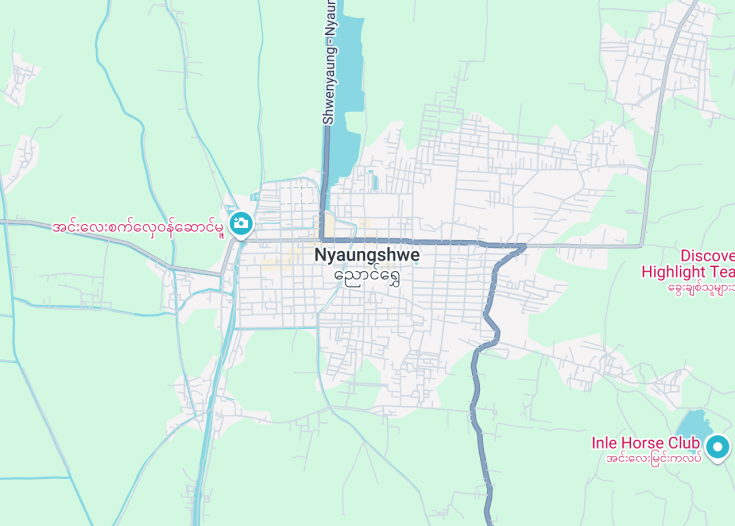Nyaungshwe in Myanmar, strategically located near the iconic Inle Lake, is a prime destination for travelers seeking serenity mixed with rich cultural experiences. The town serves as the main gateway for excursions onto Inle Lake, known for its floating gardens, leg-rowing fishermen, and stilted villages. Explorers can immerse themselves in the local culture by visiting numerous pagodas and markets or partake in traditional Shan cuisine. Its mild climate and scenic vistas make Nyaungshwe a picturesque year-round destination, perfect for those eager to explore Myanmar’s unique heritage and natural beauty.
For a truly immersive experience, make time to visit the local markets in Nyaungshwe. These bustling hubs offer a close look at the daily life and vibrant culture of the Shan people.
Plan your visit during the cooler months from November to February for a more comfortable exploration of Nyaungshwe and its enchanting surroundings.
Top things to do & see in Nyaungshwe
Select the following sights and activities to discover best tickets and tours available in Nyaungshwe.
Nyaungshwe: The Gateway to Inle Lake
| Country | Myanmar |
| Time in Nyaungshwe | GMT+6:30 |
| Language spoken | Burmese |
| Population | 29,000 (2021 Census of Myanmar) |
| Currency | Burmese Kyat (MMK, З) |
| Airports | Heho Airport (17 mi / 29 km). |
Nyaungshwe, located in the Shan State of Myanmar, is renowned for its picturesque landscapes and as the primary access point to the stunning Inle Lake, a highland freshwater lake known for its floating gardens and unique leg-rowing fishermen. The town serves as a cultural hub, reflecting the rich heritage and traditional lifestyles of the Intha people. Historically, Nyaungshwe was the royal capital of the Shan princes, which is evident in its numerous traditional monasteries and the ancient teak wooden Shwe Yan Pyay Monastery.
Where is Nyaungshwe?
Nyaungshwe is situated at the northern end of Myanmar’s spectacular Inle Lake in the western part of Shan State.
Distances:
| Route | Distance by car | Time by car |
| Yangon to Nyaungshwe | 405 miles | 10 hrs |
| Mandalay to Nyaungshwe | 165 miles | 4 hrs |
| Bagan to Nyaungshwe | 160 miles | 4 hrs 30 min |
What is Nyaungshwe famous for?
Nyaungshwe is famous for its proximity to Inle Lake, its traditional Shan and Intha villages, floating markets, and for the Phaung Daw Oo Pagoda, which hosts a highly revered annual festival.
History
Located in the Shan State of eastern Myanmar, Nyaungshwe has a rich history that is deeply intertwined with the cultural and political developments of the region. Its story begins well over a thousand years ago, evolving through various periods marked by significant historical events.
Pre-11th Century: The Early Settlements
Before becoming a central part of the Shan State, Nyaungshwe area was inhabited by local tribes who lived in stilt houses around the Inle Lake. These early settlers were primarily engaged in fishing and subsistence farming, taking advantage of the fertile grounds and abundant water.
11th Century – 16th Century: Influence of Bagan and the Shan Kingdom
Following the rise of the Bagan Empire, Nyaungshwe came under the influence of Theravada Buddhism. This period saw the establishment of the first monastic schools and the introduction of Pali scriptures. The region was later incorporated into the expansive Shan Kingdom, which influenced the development of local architecture and increased the spread of Buddhism.
17th Century – 19th Century: Burmese and Shan Rule
During this era, Nyaungshwe experienced a mix of Burmese and Shan governance, leading to a blend of cultural practices and a period of artistic enrichment. Local crafts, textiles, and religious practices flourished, supported by patronage from local chieftains known as Saophas.
19th Century – 20th Century: Colonial Influence and Post-independence
With the arrival of British colonial forces in the 19th century, Nyaungshwe underwent significant changes. The colonial era brought new economic opportunities and challenges, shifting the local economy towards tourism centered around Inle Lake. Post-independence in 1948 marked a tumultuous period for Myanmar, with Nyaungshwe navigating through political instability and economic upheavals.
21st Century: Modern Developments and Tourism
In recent decades, Nyaungshwe has emerged as a popular tourist destination, known for its breathtaking landscapes and vibrant local culture. Efforts have been made to preserve the unique cultural heritage while adapting to the demands of increasing tourism. The town continues to balance traditional practices with the needs of modern visitors.
Visit Nyaungshwe
What to see and do in Nyaungshwe
Nyaungshwe offers a blend of natural beauty and cultural richness. Visitors can explore the following attractions:
- Inle Lake, famous for its floating gardens and leg-rowing fishermen.
- The ancient pagodas and monasteries that dot the landscape.
- Local markets where traditional handicrafts are available.
- Wineries offering tastings of locally produced wines.
- Eco-tours that showcase the area’s biodiversity.
These experiences provide a deep dive into the life and traditions of the Shan state.
Cultural Festivals in Nyaungshwe
Nyaungshwe is renowned for its cultural festivals, particularly the Phaung Daw Oo Pagoda Festival. Held annually in September or October, it features traditional boat races, with rowers in colorful costumes competing, drawing spectators from across Myanmar and abroad.
Best time to visit Nyaungshwe
The ideal time to visit Nyaungshwe is during the dry season from November to February, when the weather is cooler and more conducive for exploring the outdoors and engaging in cultural events.
Is Nyaungshwe worth visiting?
Nyaungshwe is certainly worth visiting for those interested in exploring unique cultural heritage and natural beauty. The serene Inle Lake, coupled with vibrant local life, offers an enriching experience. However, visitors should be prepared for rural living conditions and less commercialized tourist infrastructure, which could be a challenge for some. Overall, Nyaungshwe presents an opportunity to witness a lifestyle that has sustained through centuries amidst Myanmar’s evolving historical tapestry.









